
A hollow earth?
“Let me show you how my Hollow Planet seismic model can explain the Earth’s seismology better than the existing solid Earth seismic model – and yet not one person at any university has shown the slightest interest in this.” — Jan Lamprecht, “Hollow Planet Seismology Vs Solid Earth Seismology“
Is the Earth really hollow? Let’s consider that idea from a scientific point of view.
It’s been a bit over 400 years since Galileo Galilee invented the telescope in the early 1600s. He then used it to look at the sky, and subsequently realized that Earth was not, as conventional “wisdom” had thought for millennia, the center of everything (Figure 1). Since that time, human scientific knowledge of Earth and space has progressed exponentially, and yet there still exits a vast amount of information that remains unknown. As Albert Einstein noted: “As our circle of knowledge expands, so does the circumference of darkness surrounding it.”
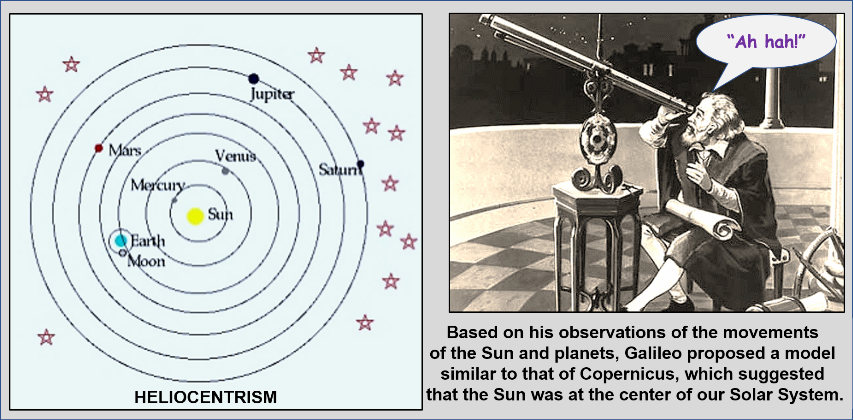
On a global scale, human awareness of this almost exponentially increasing body of scientific knowledge is spectacularly uneven. There are reasons for this lack of awareness: (1) Vastly different levels of educational opportunities exist within and among different countries, including the United States; (2) Statistically, a significant number of people have only a limited ability to grasp such knowledge, which results from that annoying normal population distribution of IQ; (3) A pervasive lack of interest in science and knowledge in general; and (4) A distrust of science and scientists within populations, which in the past few years, seems to have taken a strong foothold in a significant number of Americans.
However, application of what is termed the scientific method has provided a vast amount of factual evidence collected by thousands of astronomers, geologists, physicists, and geophysicists over the past few hundred years. This evidence overwhelmingly supports a model of Earth which contains interior layers of various chemical compositions and existing under various physical conditions of temperature and pressure with increasing depth. There exists exactly zero evidence that the Earth is either hollow or flat.
Some of the misstatements from Jan Lamprecht’s “Hollow Planet Seismology Vs Solid Earth Seismology”
It is quite clear that Lamprecht is frustrated by the apparent lack of academic interest in his ideas, and in his proposed proof that the Earth is hollow. The real reason that he has been ignored is that his premise and his “proof” are simply incorrect and lack any actual solid scientific factual support. This is the same situation bestowed on all the numerous crackpot “theories” of a hollow Earth of a flat Earth, which can be accessed on the Internet.
Hollow Earthers and their inbred cousins, the flat Earthers, support their ideas with pseudoscientific “evidence,” conspiracy theories, and paranoia. They hold onto a belief that academics and “mainstream” scientists are all in cahoots and collaborate with one another to maintain the status quo, thereby shutting out any “outsiders.” Fortunately, such narrow-mindedness is not how science operates nor how the vast majority of scientists behave.
Consider some of the quotes from his article.
“The (completely FALSE) impression schools have created in everyone’s minds is that the Earth is this red-hot ball of lava.”
Having taught geology for over 40 years at the college and university level, I can state with certainty that his statement is simply not true. However, it was recognized early in the 20th Century that very early in its formational history Earth did undergo a molten state. Subsequently it underwent gravity differentiation into internal layers based on the density of the materials (increasing density toward the center), then slowly cooled and except for the outer core became mostly solid about 4.5 billion years ago.
But then in the following paragraph he makes a contradictory statement about the same idea:
“But nowhere in modern geology or seismology will you see them saying the Earth is a ball of molten lava.”
This statement of his is correct but contradicts what he previously wrote. If you substitute the word “was” for the word “if” in his quote, you would be in tune with modern geological thinking.
“Lava is created by heat generated within the crust of the Earth. The crust is said to be no more than 20 miles thick, although to be honest nobody has ever actually penetrated the crust so we really do not know what (if anything different) lies beneath it. Scientists will tell you that lava is a crustal phenomenon and all lava comes from no deeper than 20 miles down.”
That’s an inaccurate statement. The older term “crust” is now considered part of the lithosphere, which is at least 60 miles thick, and it is directly underlain by what is termed the asthenosphere (refer to figure 7). We also have some igneous rock samples which formed below the “crust” and as a result of deep-seated volcanism they were extruded onto the surface. There are also intrusive igneous rocks which formed below the surface but have now been exposed by erosion. Examples are the rocks of Pine Valley Mountain and the Sierra Nevada.
Actually, we have penetrated the crust all the way to the center of Earth using earthquake seismic wave studies (remote sensing). These studies have provided a reasonably accurate model of the composition and thickness of the layers within the Earth. Furthermore, within certain areas of the lithosphere, heat melts rocks, which is known as molten liquid magma, and if this magma reaches the surface and erupts, only then it is termed “lava.” Examples of this process, among many, would be the Japanese Islands and the Cascade Range, and closer to home all of the volcanic cinder cones and lava flows around St. George.
“In fact, the final proof comes from seismology itself. When an earthquake occurs, seismic waves travel out in all directions throughout all the earth. There are two types of seismic waves: P and S. Based on this, scientists know that all of the earth is actually quite RIGID and composed only of rock. The only partial exception is the Outer core.”
In fact, there are at least three types of seismic waves generated by an earthquake. They are termed Primary “P” Secondary “S,” and Long “L” waves (Figure 2). Within the Earth there is an asthenosphere, which is not solid but rather is a ductile viscous solid, kind of like silly putty. Well below that is the outer core, which is in a liquid state. Seismologists recognize these layers and their thickness by charting the velocity changes of P and S waves as they travel through the Earth. Because the interior of a hollow Earth would lack strength and rigidity, these seismic waves would not behave as they are currently recorded.
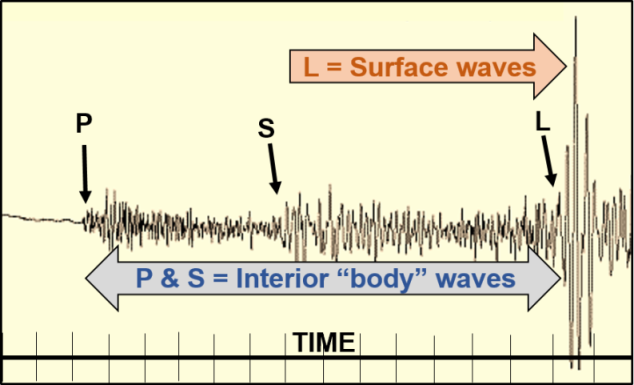
Although there are numerous other statements that can be discussed, for space considerations I’ve skipped to one of the last comments in his article:
“According to scientists, pressure increases with depth. According to their calculations the pressure is so great that between 70-150 Km down, all rock will begin to flow. Below 150 Km there is no known material which will not flow. Therefore, according to scientists, there can be no earthquakes with epicenters deeper than 150 Km – because it is IMPOSSIBLE! But there are! Tens of thousands of Earthquakes have epicenters deeper than 150 Km.”
First, his statement seems to disregard the effect of increasing pressure and compositional changes with depth. Under greater confining pressure materials can remain in a solid state even if the temperature exceeds their melting point at the Earth’s surface.
Second, deep focus earthquakes are known to occur along subduction zones. These zones result from collision of lithospheric plates as part of plate tectonics (Figure 3). At depths below the asthenosphere (700 Km) are essentially solid rocks of the mesosphere (older term “mantle”). This is due to the increase in confining pressure and chemical composition of the rocks. At about 2,900 Km, the temperature overcomes the pressure and the rocks, which are metallic based on their high specific gravity, and thus the rocks melt. This depth is the boundary of the Earth’s outer core.
Also, note his incorrect use of the term “epicenter.” An earthquake epicenter is the geographic location on the Earth’s surface above where the actual earthquake fracture occurred. The actual break within the Earth is known as the focus not the epicenter.
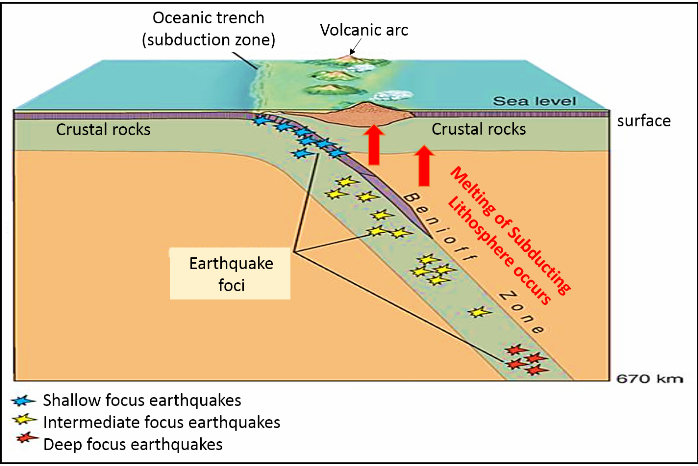
Some of the things we know about the Earth
The sun is the center and contains about 98 percent of the mass of the solar system (Figure 4). The planets, various satellites such as the moon, and other objects such as the asteroid belt all circle the sun.
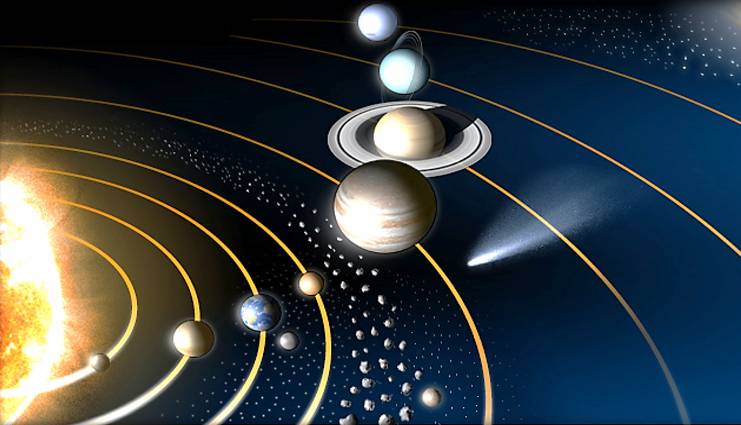
Earth is the third planet out from the sun and has one satellite called the moon. Earth is the largest of four terrestrial (rocky) planets of Mercury, Venus, Earth, and Mars in the solar system. However, all of these are smaller than the larger Jovian planets, which are primarily gas and liquid. The equatorial diameter of Earth is 7,926 miles, and the polar diameter is 7,898 miles. Thus, Earth is not a perfect sphere.
Earth has a geographic axis with a north and south pole and currently spins on that axis approximately 365 days during its one-year journey around the sun. However, that spin rate is known to have been decreasing throughout geologic time (Figure 5).
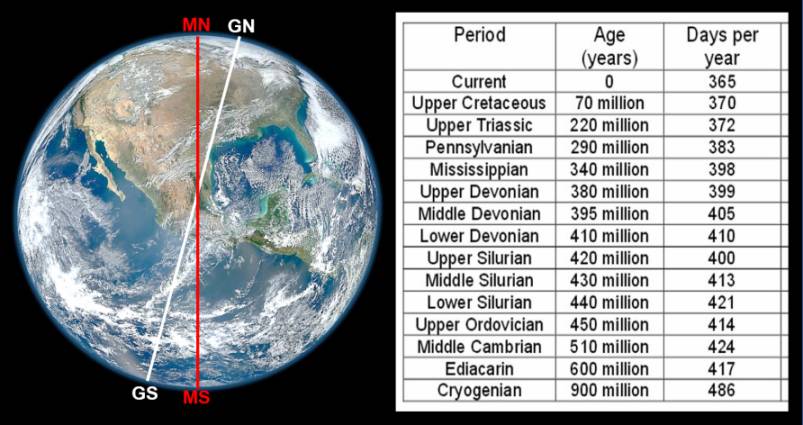
Earth has a bipolar (or dipolar) magnetic axis with a north and south pole. This axis is not aligned with the geographic axis (Figure 5 above) and its axis tends to wander as well as periodically reverse itself (Figure 6). This magnetic field is generated within the Earth’s metallic composition (iron/nickel) outer liquid core.
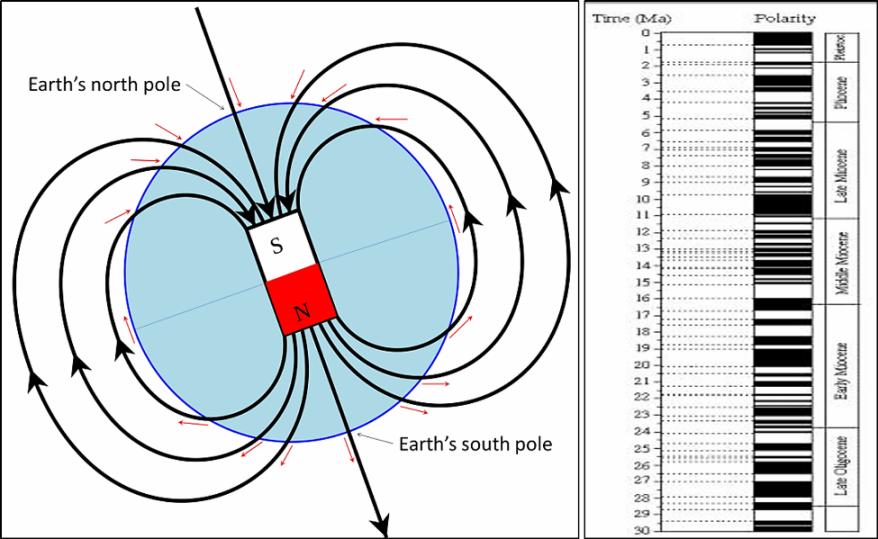
During the past 100 years, radiometric dating techniques for rocks and minerals has provided a numerical time scale for the Earth, and evidence of Earth formed minerals about 4 billion years old. Similar dating techniques have been applied to materials brought back to Earth from the Apollo missions to the moon and from meteorites found on Earth, which indicate that solid objects within the solar system, including Earth, are at least 4.5 billion years old.
Earth has an average specific gravity (or density) of 5.5 g/cm3, although the outermost layers have a lower specific gravity and the innermost layers have a much higher specific gravity (Figure 7).
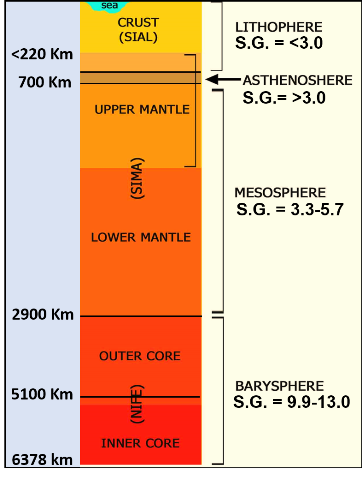
Based on its overall mass, Earth has a gravitational acceleration (rate of an object falling) of 9.8 m/sec2.
At the present time, Earth is the only planet known to have a biosphere (life), although planet Mars and one moon of Jupiter known as Europa, may have currently, or had in the past, living organisms (a biosphere).
Modern geophysical evidence from studying earthquake generated P and S seismic waves has provided a reasonably detailed model of the Earth’s interior structure (Figure 8).
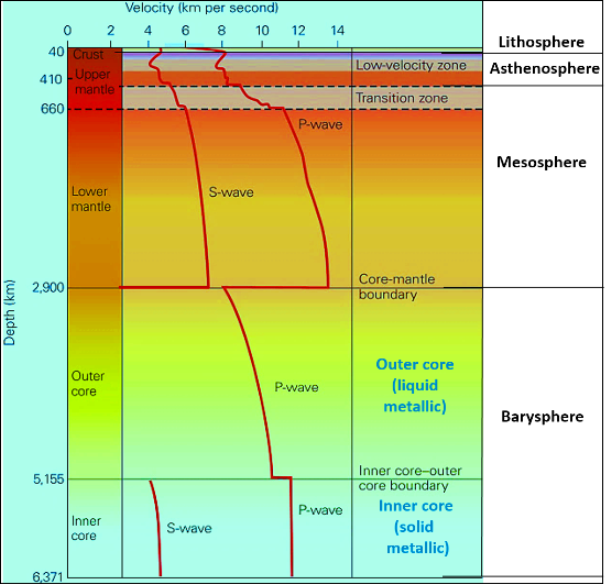
The mesosphere/outer core boundary represents a change from solid to liquid. The outer core/inner core boundary represents a change from liquid to solid. Velocity of both P and S waves decreases in the ductile asthenosphere (low velocity zone). At the liquid outer core boundary, S-waves stop, and P waves decrease in velocity.
Evidence of a non-hollow Earth
What scientific evidence supports a non-hollow Earth?
The immense pressure deep within the Earth would not allow for a hollow center. Think of a submarine diving to depths within the ocean. As it gets deeper the pressure increases on the outer hull. If the submarine gets too deep, the immense pressure of water will eventually cause the hull of this hollow submarine to implode. Because rocks have a much higher specific gravity (or density) than water, the immense pressure increase with depth would not allow for any hollow areas within the Earth.
This fact seems to have been ignored in the 2008 Hollywood movie “Journey to the Center of the Earth” and by Jan Lamprecht in his book and blog.
Average specific gravity of Earth at 5.5 gm/cm3 is much too high for the interior to be hollow. Because the outer layers of the Earth have a specific gravity of less than 3.0 gm/cm3, the interior layers must have a specific gravity significantly greater than 5.5.
Presence of Earth’s magnetic field is the result of a liquid outer metallic outer core which is spinning (Earth spins on its axis). “The magnetic field is generated by electric currents due to the motion of convection currents of molten iron in the Earth’s outer core: these convection currents are caused by heat escaping from the core, a natural process called a geodynamo.” (refer to Figure 6).
Gravitational pull (9.8 m/sec2) would be considerably less if the Earth were hollow.
Changes in velocity of various earthquake seismic waves are due to changes in the physical properties and chemical compositions of the various interior layers. None of these velocity changes can be matched to a hollow Earth.
In conclusion, application of the scientific method (Figure 9) from various fields of scientific study have conclusively indicated that the interior of the Earth consists of various spheres, from the outermost lithosphere to the innermost part of the core. There is no verifiable evidence that any part of the interior is hollow.
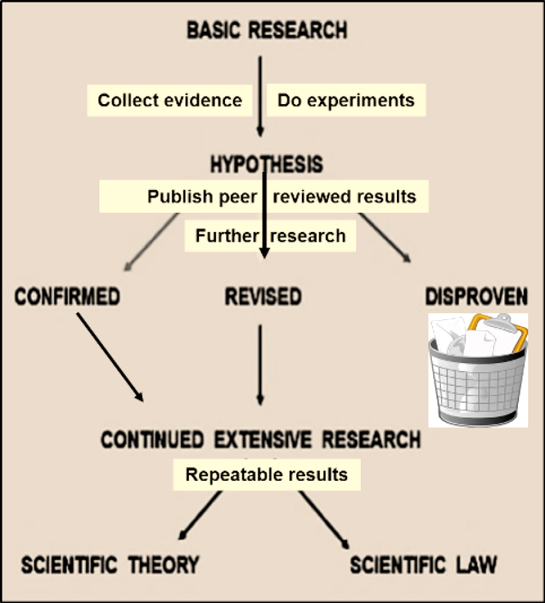
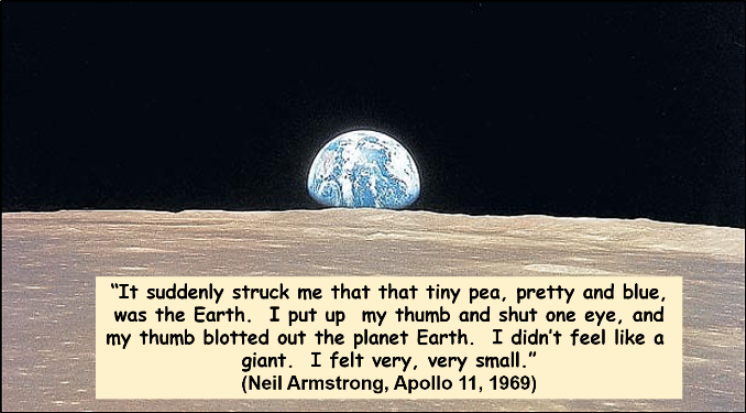
The viewpoints expressed above are those of the author and do not necessarily reflect those of The Independent.
How to submit an article, guest opinion piece, or letter to the editor to The Independent
Do you have something to say? Want your voice to be heard by thousands of readers? Send The Independent your letter to the editor or guest opinion piece. All submissions will be considered for publication by our editorial staff. If your letter or editorial is accepted, it will run on suindependent.com, and we’ll promote it through all of our social media channels. We may even decide to include it in our monthly print edition. Just follow our simple submission guidelines and make your voice heard:
—Submissions should be between 300 and 1,500 words.
—Submissions must be sent to editor@infowest.com as a .doc, .docx, .txt, or .rtf file.
—The subject line of the email containing your submission should read “Letter to the editor.”
—Attach your name to both the email and the document file (we don’t run anonymous letters).
—If you have a photo or image you’d like us to use and it’s in .jpg format, at least 1200 X 754 pixels large, and your intellectual property (you own the copyright), feel free to attach it as well, though we reserve the right to choose a different image.
—If you are on Twitter and would like a shout-out when your piece or letter is published, include that in your correspondence and we’ll give you a mention at the time of publication.
Articles related to “A hollow earth?”
Our Geological Wonderland: A self-guided field trip in and around St. George
Our Geological Wonderland: Examining the Biblical Great Flood




Science is fine. Yep, likely the Earth is not hollow, but then again who can say there are not vast underground sub surface regions that support life, or the possibility of subterranean civilizations. The author herien clearly derides those that disagree with his consensus Scientific view. Clovis arrowhead Americas theory – bye bye. Gobekli Tepi, bye bye to 300 years of Academic snobbery that nothing existed prior to 5000 BC but hunting and gathering. String theory, hmmm, an elegant mathematical puzzle? I have no issue with Science, but oneupmanship and deriding those that disagree with the almighty scientific consensus is a flaw of close minded egos. What if we discover the Universe is truly holographic and more like a virtual matrix of information -then HA Ha, the Earth is truly flat!!!! Lol
Great comment!
Yes, you do have a problem with science, and apparently a problem with reading comprehension.
“…who can say there are not vast underground sub surface regions that support life, or the possibility of subterranean civilizations.” You are clearly not much into rational thinking or physical evidence. It is simply impossible for areas deep within the Earth to be open or hollow, or even flat. It’s called physics. The pressure within the Earth will simply not allow that to happen (accept in Hollywood movies or in).
The entire premise of science is to determine answers; consequently scientific evidence is continuously being revised as new evidence is discovered. Yes, scientists have egos, and yes some are closed-minded (note correct spelling or optional closed-minded). However, when new discoveries are made and verified, most will change their perspective. I’ve seen this happen a number of times through my 50 plus years as an academic scientist.
Yes, derision and one-upmanship (note correct spelling) is appropriate when someone refuses to accept evidence. Stupidity is understandable; ignorance is not!
Oh yeah, don’t forget that the moon is made of cheese; we’ve never landed there; climate change is a hoax perpetrated by the global elite; evolution does not occur; the Earth is the center of the Universe; we are all part of a giant hologram; DDT does not harm organisms; smog is not related to automobile exhausts; vaccinations will cause autism; smoking cigarettes does not cause any health problems. Yup, you can clearly see that science sucks.
Cheers,
Rick Miller
Yes, *great comment”! First lie you made. Then attack!!!! Then deride!!! Then back up with garbagio examples. Big ego scientific derisive comment and diatribe. So typical of a self righteous Scientific nutt. Look up Mr genius, the moon ringing in a vibrational way as recorded by NASA, oh but it is made of Cheese. Science is not a religion dude! It is a process. What is fact today is bullcrap tomorrow after a new scientific analysis overrides the previous consensus. You are a typical academic. You are A God. Everybody else are just sub human fools. Sincerely, Fool Can ellivate, and this fool knows HE DOES NOT KNOW. Please attack more. I love it and could care less how the spelling works out. Righteousness is a disease. L o L. You are in a battle and your opponent is a windmill. Change is a good thing. But your God is Science. Not a God. Only you. Peace love and Bobby Sherman.
Science brought us biological warfare. Science brought us nuclear weapons. Science is a two edged sword, and the lack of humility by the the devotees of Science is the root of future exstinction of all humanity. You are the problem, not the solution. There is another way. Good luck.
Recently, a geologist and engineer published a book on which he demonstrates, based upon recent research and internal inconsistencies, that the orthodox scientific paradigm of a solid earth is wrong. https://www.amazon.co.uk/Earth-Really-Solid-Evidence-Reexamined-ebook/dp/B07W89TJG4/ref=sr_1_1?keywords=is%20earth%20really%20a%20solid%3F&qid=1565641455&s=books&sr=1-1&fbclid=IwAR2-YRFrz2T5kmwDJo1otT_t9Nxw6riwgyAJRcnlqRokSGIRq93BO6WVNi8
Thanks Oliver.
At first glance, reading over the Amazon blurb for the Kindle edition, I see the same pseudo-science buzz words about how mainstream science is wrong, but his “…novel and more reliable technique, which is the right one.” Not a good sign of legitimate work, and does sound like strong self-promotion.
Also, I couldn’t find who published the book. A legitimate, review process publisher, or a self-publishing house with no editorial input.
Rick Miller
maybe
Do you have an email address for Mr Lamprecht please ?